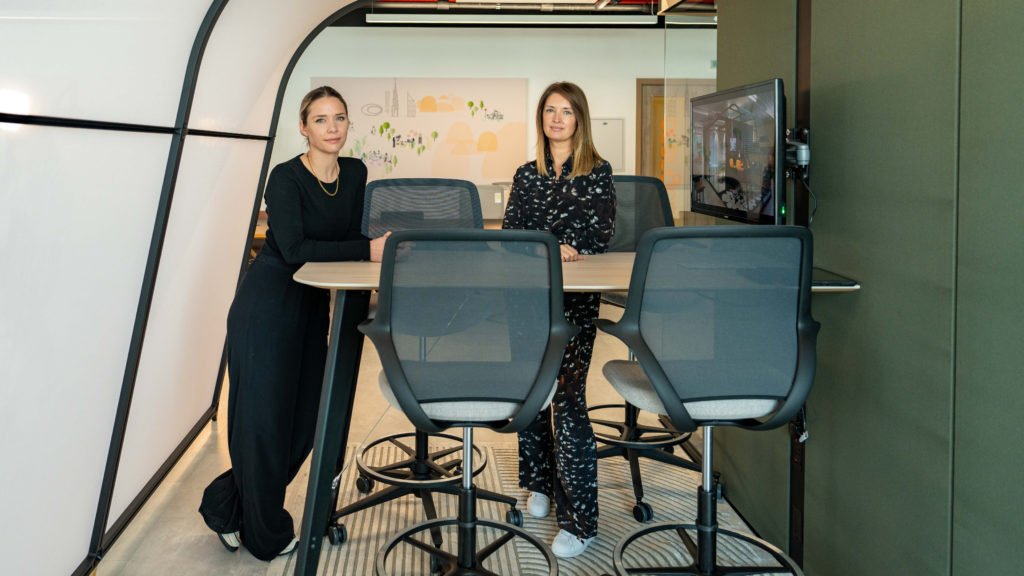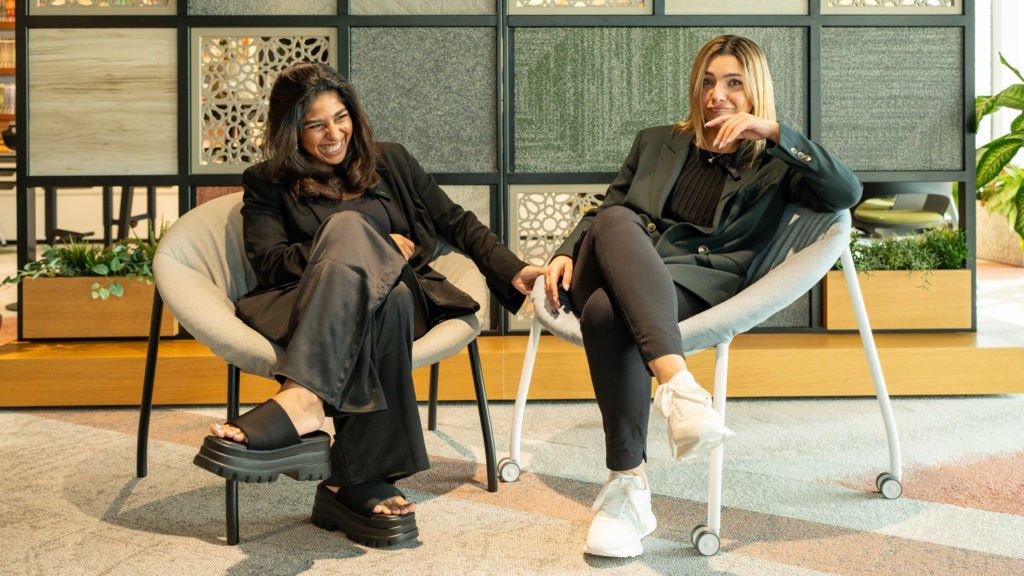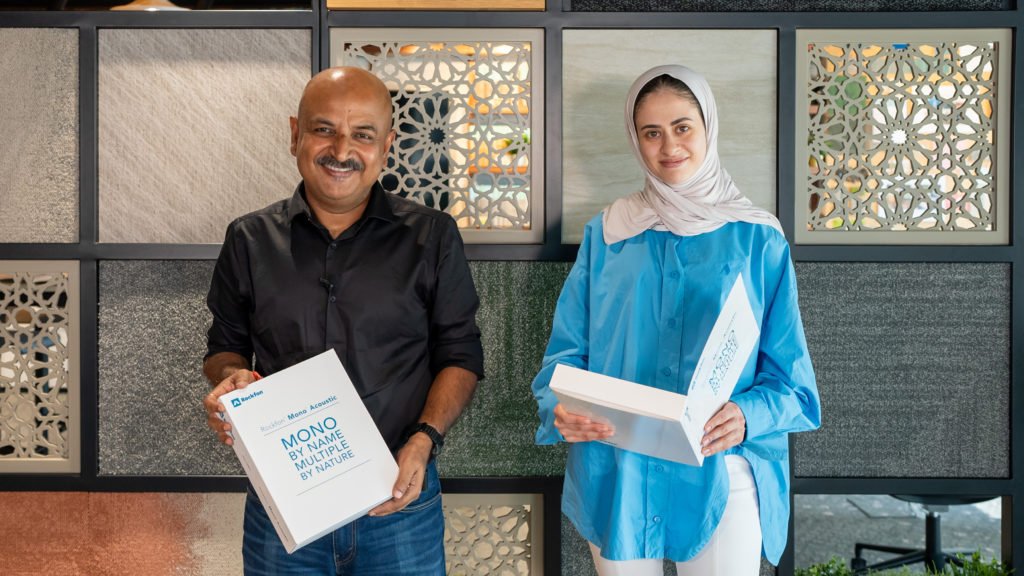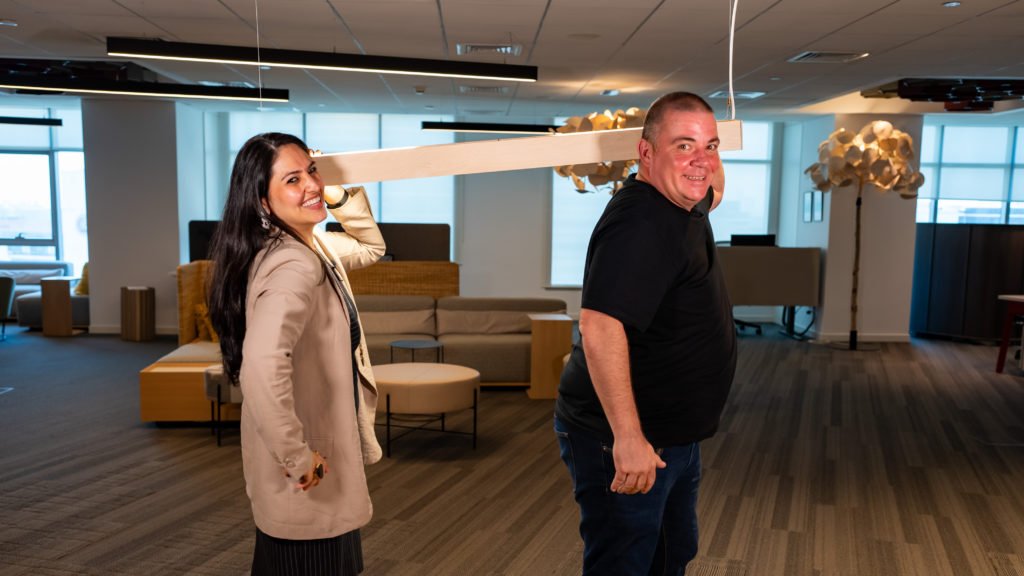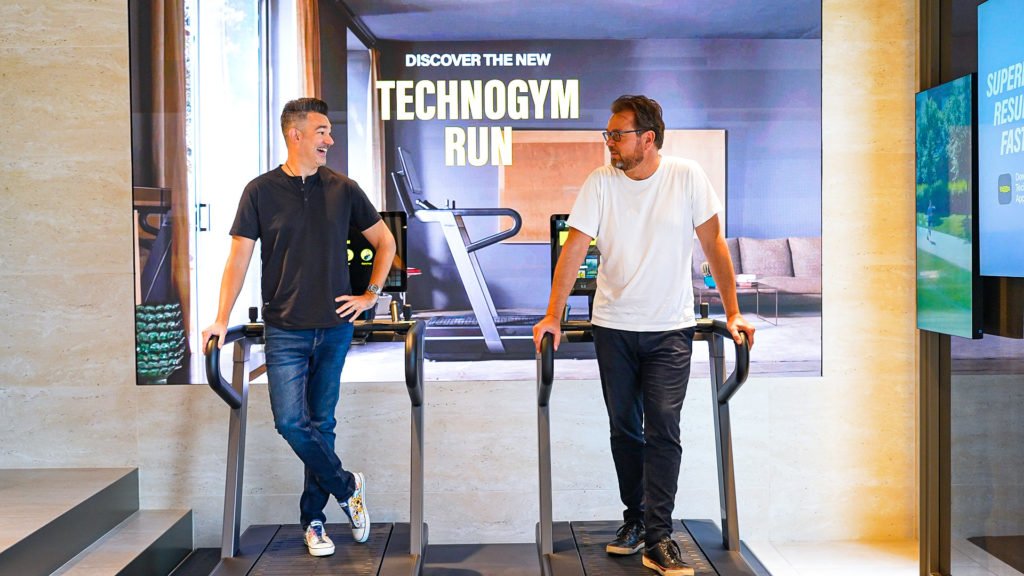Dyson’s latest product, the Lightcycle, is a beautiful blend of cutting edge, lighting technology and human-centered design, both in form and purpose. Together with designers Adriana Graur of Perkins+Will and Ahmed Saliem of Nulty, we reviewed this impressive combination of engineering and design at Dyson’s Dubai offices, with Dyson’s EMEAs Specification Manager, Marc Lemmens, giving us much insight on the development and technology behind this innovative product.
The Review Crew
Above from Left: Adriana Graur, Interior Designer at Perkins+Will, Ahmed Saliem, Designer at Nulty Lighting and Marc Lemmens, EMEA Specification Manager at Dyson
For an item that would ordinarily be placed in the commoditised category of task lighting, the Lightcycle is a truly spectacular, albeit high end product that clearly stands out from the competition. With the Lightcycle, Dyson aim is to help us take back control of the conditions under which we work, starting with light.
“Interior designers usually have task lighting at our desks… I know I do,” says Adriana. “It’s not bad, but the light can feel too strong over time. And I work long hours, staring at a screen. So I know first hand how important light is for my wellbeing.” She echoes a common sentiment felt by almost anyone who’s worked in an office past sunset. But unlike Adriana, most people don’t even know it’s the light that’s hurting their wellbeing.
The Lightcycle is a result of Jake Dyson’s commitment to enhancing the individual workspace experience through his vision of high quality, personalised task lighting. Considering that the modern worker spends around 90 percent of their time indoors under artificial light, we do a poor job of educating ourselves on the effects of light. A statement that is reinforced by studies claiming the negative effects of poor lighting on our health – poor sleep, headaches, eye strain and, in extreme cases, depression. And given that this is a global concern, it should be clear why we need products that improve the lighting conditions we work in.
Our eyes are over exposed to blue light from the displays on our digital devices, which are bombarding our optic nerves to the point of irreversible damage. Combined with the fact that the Middle East’s predominantly hot climate forces us to spend most of our time indoors, this means we’re exposed to artificial lighting in almost every waking moment.
Why take task lighting seriously?
“The general public doesn’t have a clear understanding of what lighting designers do. It’s not specifying or designing the best looking light fixtures for a space. It’s so much more than that. We have to thoroughly understand the built environment, who’s working in it, and what type of work will be done. This informs the products we pick and, in turn positively affects your productivity and wellbeing,” says Ahmed.
To help us understand the intention behind the Lightcycle’s design, Marc first explains the relevance of light in our lives, and how today’s work culture and technology is affecting our health. “If you look at the prevalence of artificial lighting from the perspective of human evolution as a whole, you’ll see it’s barely been around, almost negligible in fact,” he says. “But its impact on our lives today cannot be ignored.”
Human, animal and plant behavior is modeled around 12 hour cycles, based on the amount of sunlight in the day. We’re hardwired for it. But we push ourselves beyond this programming by working into times with no sunlight, with the help of artificial lighting. This affects us in several ways, and severely impacts our circadian rhythm (a 24-hour physiological process that regulates sleep and wake cycles). In an ideal state, this rhythm would follow sunrise and sunset, and adjust our sleep and wake cycles accordingly. But because we’re exposed to artificial or blue light throughout the day, our internal clock can go haywire.
Why is this so important? Besides sleep, it also manages the release of melatonin, which in turn releases antioxidants and fights free radicals. The quality of sleep and melatonin is related to the risk of cancer and other dangerous ailments.
“The quality of light we expose ourselves to is far more important than we know. Yet, we take it for granted,” says Marc.
The Lightcycle has an impressive level of engineering and aesthetic detail to it. And is possibly the most advanced task light we’ve ever come across. The product’s most powerful and useful feature is its ability to intelligently track daylight and automatically adjust colour temperature and brightness throughout the day. It mimics the natural light conditions at your location to give you the best possible lighting conditions during that time of day, depending on the type of activity you’re engaged in.
“Our body clocks have historically been mapped to the orange to blue wavelengths throughout the day,” Marc explains. “Red to orange shades around sunrise and sunset, and bright blue around midday, a result of sunlight being scattered at different angles by the atmosphere. By mimicking these light conditions, the Lightcycle provides the best possible conditions for us to work, so we’re not plagued by constant fatigue and eye strain.”
Here is where we geek out.
The Lightcycle’s optical head contains technology with software embedded that employs a unique GPS driven algorithm for daylight tracking, validated by millions of data points that describe the daylight present at your current location, anywhere on earth! The. The output of that algorithm tells the hardware what colour and intensity should be emitted, and the LEDs automatically adjusts to deliver the right amount of intensity and right colour temperature in tune with your circadian rhythm. The ambient light sensor not only senses and adjusts light levels based on surrounding light, but also handles sudden changes, maintaining a constant light level.
Aesthetics
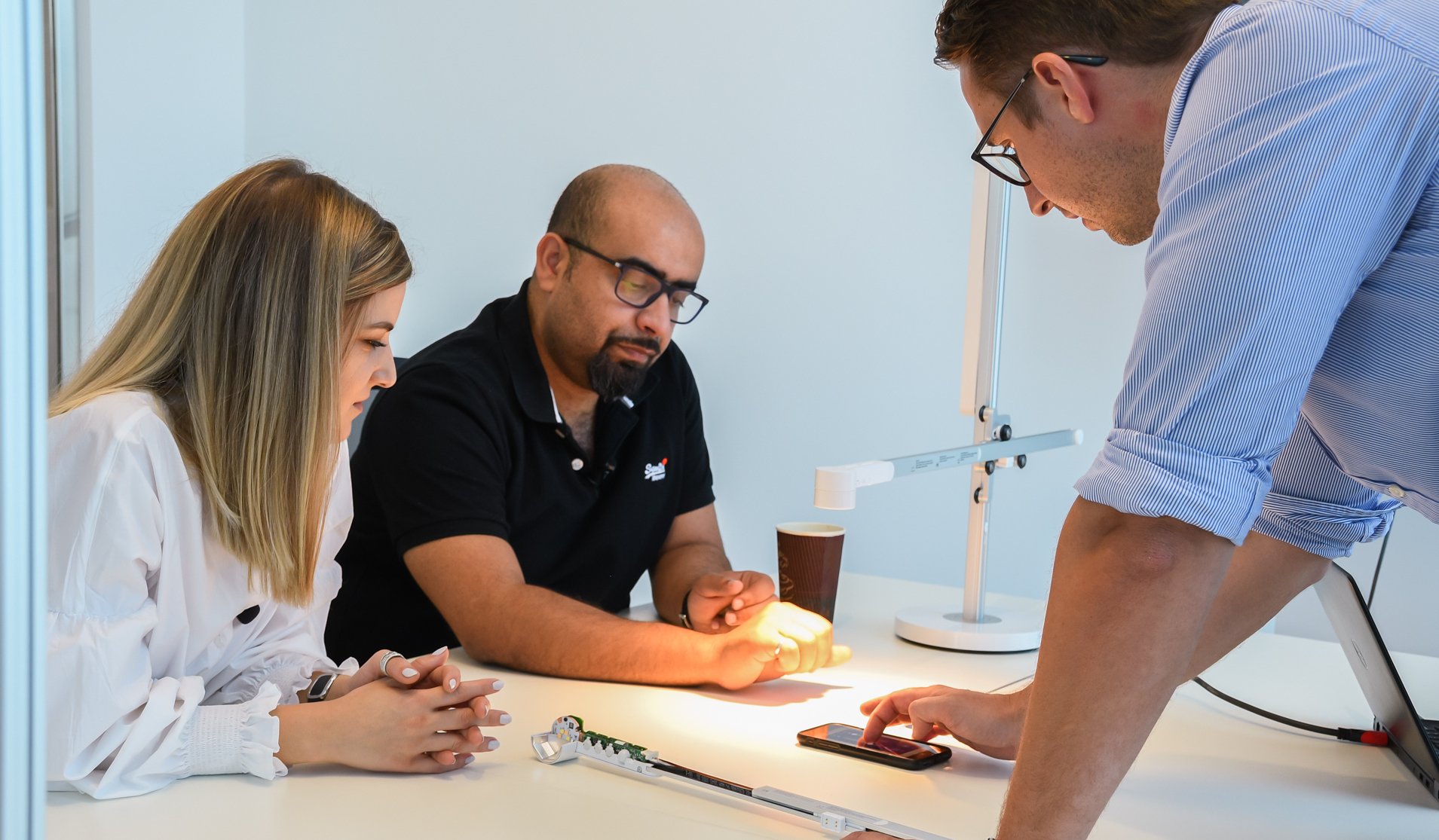
Adriana: It checks all the boxes when it comes to aesthetics; it’s clean and concealed, yet shows off its design in an understated way. Plus the ways to interact with it are obvious, which is a great thing. What I like about the Lightcycle’s design is how you can get good lighting with minimal effort. One of its best aspects is how seamless all the controls and features are.
Ahmed: The product’s aesthetics are beautiful. The quality of light as well as it’s surface area is impressive. And it looks elegant and futuristic, a mix of organic and modern. I also love how you can make it so personal.
The Sustainability Angle
The LEDs that generate light through the Lightcycle, or any other lighting product, are subject to deterioration and burn-out from the large amount of heat generated during operation. When LEDs overheat, they fade and discolour. This presents a challenge to sustain the quality of the light and overall product over a long period of time. Even more so in the case of the Lightcycle for if the right colour and temperature can’t be provided, the Lightcycle is rendered useless.
Dyson engineers addressed the overheating problem by taking inspiration from technology used in satellites. A vacuum sealed copper tube draws heat away from the LEDs. A drop of water evaporates inside the tube, dissipating heat along the pipe as it condenses, before returning to the LEDs by capillary action. The entire process becomes a continuous, energy free cooling cycle. With this heat pipe cooling technology, the light quality can be maintained for 60 years. Long Lasting LEDs result in a genuinely sustainable product in terms of energy consumption and shelf life. The Lightcycle also has a low carbon footprint and will last 181,000 hours – far longer than the average task light.
Furthermore, an infrared movement sensor detects movement within the Lightcycle’s vicinity and switches it on and off accordingly. It helps save energy when not in use. Not only that, it is connected to the Dyson app and behaves according to the mode set.
The sensor can be switched off in study mode, or in do-not-disturb mode, so it doesn’t switch on when sleeping. It can also be tuned with the Wake-up mode, so it remains activated during working hours in the day.
Adriana: When we think of sustainable furniture, we take a holistic approach and look at its entire lifecycle – from manufacture to disposal and recycling. The same should be done for lighting as well. With the heat pipe technology, LEDs can last for a really long time. That means less frequent need for replacement or maintenance.
Ahmed: I’ve never heard of this level of engineering in a product of this grade – 60 years is a long time for LEDs. Also think about all the energy that’s being saved in combination with the motion sensor. Even a 1% reduction across thousands of devices goes a long way
The Dyson Link App
The mobile app is where users can really feel the control and flexibility possible with the LightCycle. The app connects your phone to the Lightcycle via Bluetooth to provide a highly personalised experience. The daylight tracking ability is closely synced with data from the phone. Once a profile is set up, it uses the phone’s time, date, and GPS data to feed into the daylight tracking algorithm. Also available are pre-set task modes, such as Relax, Precision, Study, and Boost, to support your current activity. Set it up for an afternoon boost when needed, or dim it down in the morning when there’s enough sunlight.
Functionality & Customisation
The design excellence of the Lightcycle isn’t just limited to the lighting technology. A counter balance is present to prevent the optical head from dropping. The 3 Axis Glide™ motion needing minimal effort, and the slide touch control for dimming is smooth and precise. In fact, we found that playing with this mechanism was fun and quite addictive!
We were informed that the product is currently available in just two finishes – white/silver and black/black. “But we want more colours!” exclaim both designers. For interior designers, being limited to just two finishes makes it hard to specify. Marc acknowledged that custom colours could be a possibility, but this would only be considered on a case by case basis, depending on the project and the quantity of the order.
Adriana: The way it moves. So smooth and elegant, you actually don’t get that in other task lights. The counter-balance is just right, and further adds to the flexibility.
Ahmed: It’s clear and comfortable. There’s no complex of way of adjusting and using the product. It’s through your app or a touch on the sides.
Final Thoughts
The Lightcycle is far ahead of the curve when it comes to lighting technology. We can’t think of too many products that can surpass its functional quality.
Marc did admit that in some cases, the client does have to be educated on the uses and benefits of this light, and why it is worth the investment, considering that it is a fair bit more than the price of an average task light.
“People don’t even know there’s a night setting in their phones. And most who do, don’t even know why they need it. People need to be educated on the importance of proper lighting”.
Overall, the Lightcycle is a phenomenal product and sets the bar considerably high. While its price point may present an uphill battle for adoption, there’s little competition when it comes to the Lightcycle’s product life and sustainability.
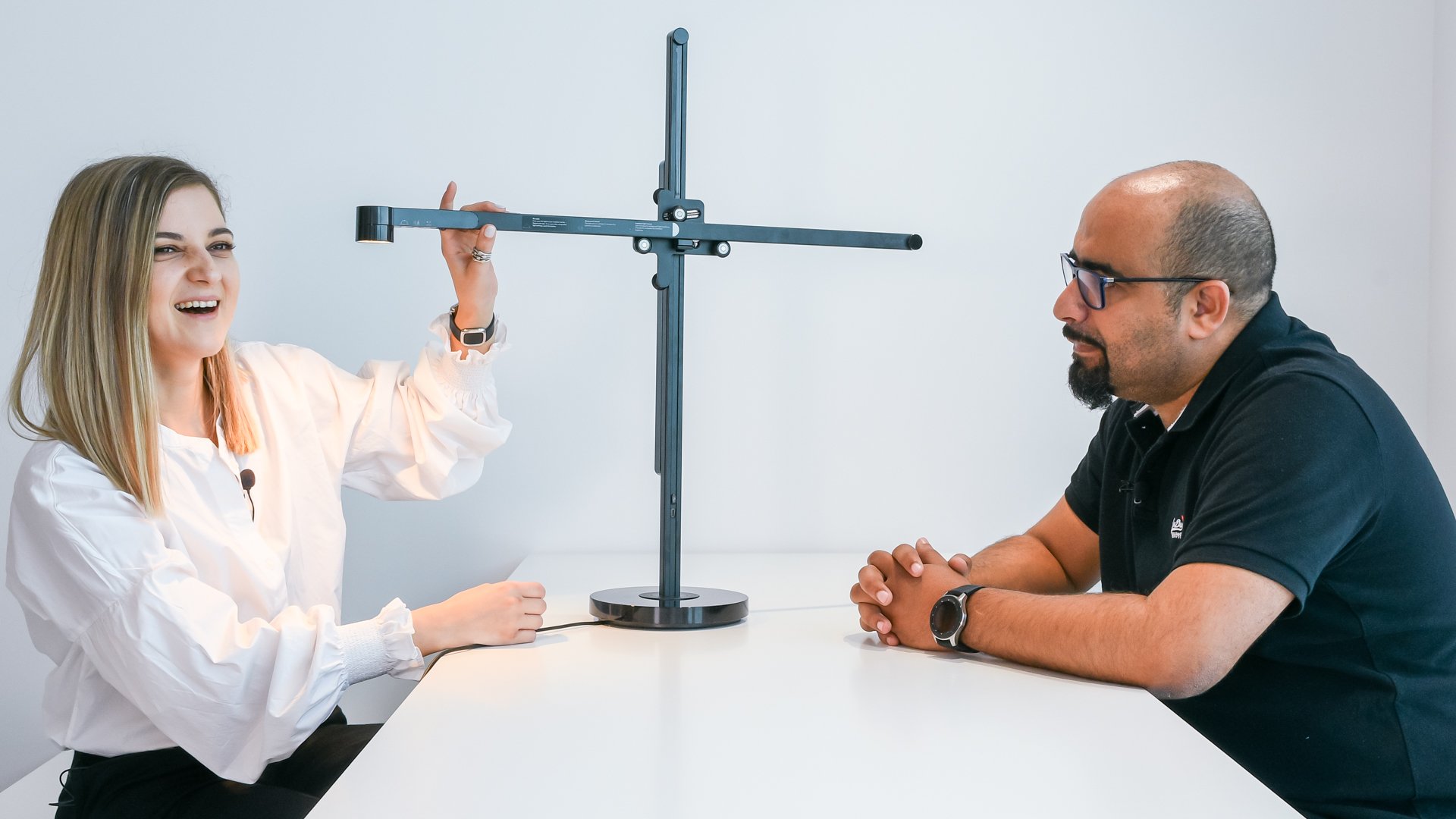
Adriana: A big part of understanding the Lightcycle’s value is understanding the true benefit of working in good quality light. It is expensive, but justified in the long run. And just like we educate our clients on sustainability, we should be doing the same for lighting as well.
As interior designers, we’re committed to designing environments and educating clients on the importance of good lighting. If clients don’t understand the importance of it, they won’t appreciate the product. Personally, I’d love to use the Lightcycle at home too, not just the office.
Ahmed: It appears to have been designed very thoughtfully and carefully – human-centered design in a true sense. This product is definitely a conversation starter. Also, in terms of thinking about what task lighting really needs to be, it differentiates itself so well from the competition. Not just from the design but also from the hardware used to provide the light. Clients in the Middle East are yet to fully understand the value of a lighting designer. No one is quite certain of what value we contribute to a project. Once they see the value, it becomes far easier for us to recommend the Lightcycle, because it fulfills all those requirements. Besides… it’s just a great looking piece of technology to have at your desk!

